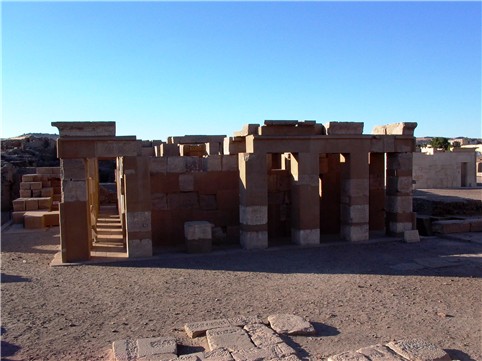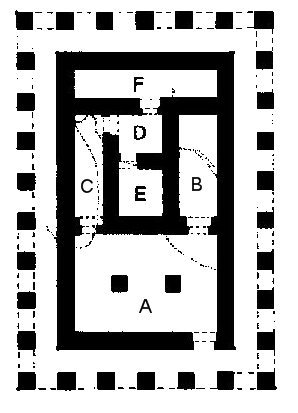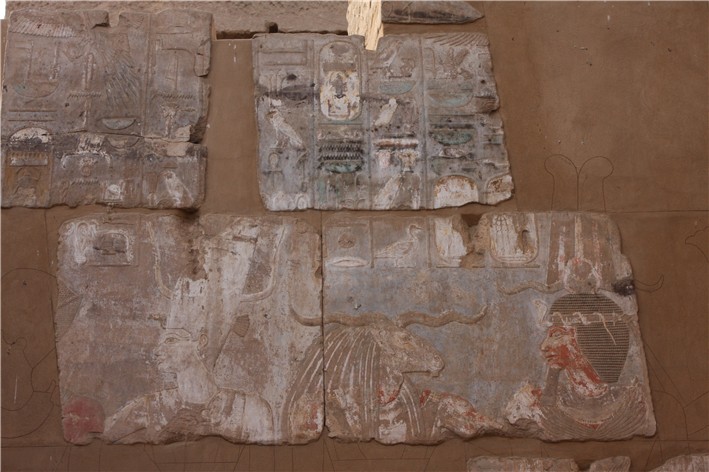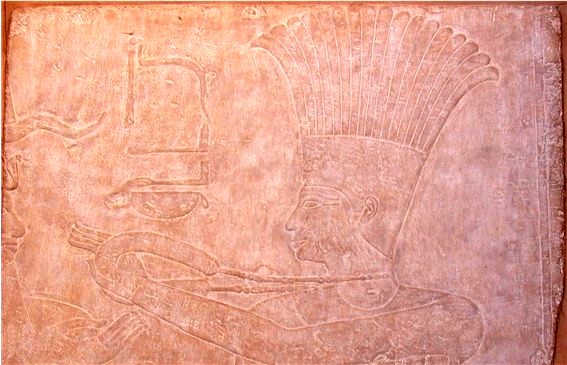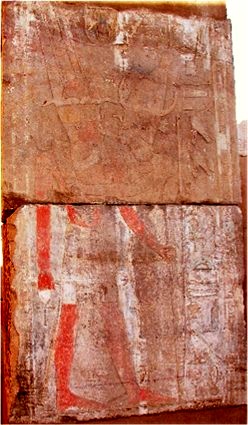|
The Temple of Satit at
Elephantine |
last update:
03.01.2012
|
| On the island Elephantine Hatshepsut has erected a small temple dedicated
especially to Satit (Satis). However, also the two other members of the triad of
the cataract region, Khnum and Anuket (Anukis), were worshipped there. However,
Hatshepsut could not complete the temple, this was done by Thutmosis III. |
| Later the temple of Satit - as well as that of Khnum - has been destroyed or was taken down.
During the 30th Dynasty both temples (or their remains) were replaced by new
buildings erected by Nektanebos II. |
| Particularly in the foundations of the
Ptolemaic temple of Satit numerous blocks from preceding buildings of the Middle Kingdom and the 18.
Dynasty were discovered (Kaiser, MDAIK 26, 1970). Until 1971 already more than 350 blocks had been recovered and gave a
sufficient basis for the reconstruction of the 18th Dynasty temple of Satit (Kaiser,
MDAIK 27, 1971). Later, additional blocks were assigned to the building, among
them copies from 21 plates with relief which are in the possession of the Louvre. |
| The following photo (left) shows the east side of
the restored temple with the entrance on the right (northern) side. The floor plan of the central building including the gallery
is shown on the right side.
The positions of the granite rocks which formed of the original cult place
are indicated by broken lines. |
|
The small temple of the 18th Dynasty consists of several rooms and a surrounding gallery.
The surface area of the temple including the gallery is 20.1 x 13.72 ms, that of
the core structure is 15.9 x 9.5 ms. In comparison with the preceding building
of the Middle Kingdom the surface area was doubled in the 18th Dynasty (Kaiser, MDAIK 36, 1980). Among others the addition of a room dedicated to Amun might
have been a reason to increase the temple. |
|
Atypically, the entrance is shifted to the right side of the temple (see floor
plan above), it leads to a hall (Room A) with 2 pillars decorated with Hathor-heads
(see photo below). From the hall the right (northern) doorway leads to a chapel
dedicated to Amun (Room B).
|
| The left (southern) door in the hall leads through a corridor
(Room C) to the anteroom
D, and from there into the sanctuary of Satit (E). The investigations of the
Old Kingdom temple whose remains are to be seen under the temple of the 18th
dynasty have shown that the arrangement of the rooms of the 18th dynasty temple
and their doors reflects the arrangement of the Old Kingdom temple.
|
|
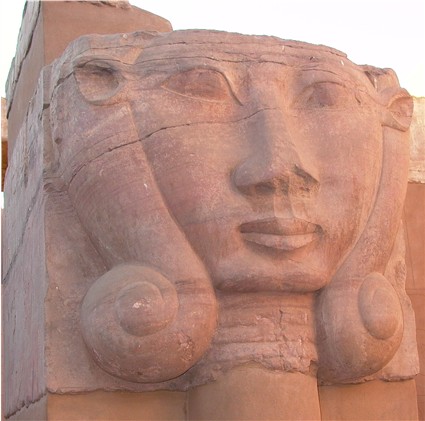
|
| The entry hall impresses by two pillars with well
preserved Hathor-capitals (see above). |
|
Hatshepsut completed the erection of the building but could not finish its
decoration in raised relief.
Originally, the rooms A, B, and C as well as the external walls of the central
building had been decorated by her.
|
| The rooms D, E, and F were completed - in sunk relief - by Thutmosis III
and also pillars and architraves of the gallery (Kaiser, MDAIK 36, 1980). Today, the decoration of walls and pillars generally show Thutmosis III mainly
in front of the members of the triad of Elephantine. |
| The purpose of these rooms may be assessed on the basis the
scenes.
|
| In the wall scenes of room A Satit appears 4-times, as well as
Amun, Anuket, Khnum and possibly Atum-Ra (all 1-times), on the columns Satit is
represented together with the king 3-times and Khnum 2-times with the king.
Thus, it appears not possible to assign this room to a special divinity -
probably this area replaces the room for the holy bark (which would be missing
otherwise). |
| Room B shows on its side walls scenes, in which 2x Satit and 1x
Khnum are the recipients of the ritual actions. Of much greater importance is
the prominent representation of the Amun-Ra on the rear wall of the room, which
therefore probably was dedicated to the cult of Amun-Ra. |
| Room C shows on its two long sides two large offering
scenes before Satet. Furthermore, only Khnum and Anuket appear in additional
scenes, whereby the representation of Anuket as together the king at the rear
wall appears particularly emphasized. Most likely, this had been the room for
the offering table for Satit. |
| Room D connects the rooms C, E and F, and is probably
not dedicated in particular to special divinity. In the scenes Satet and Khnum -
in each case 2-tmes - as well as Anuket (1-times) are the recipients of
the ritual actions. |
Room E contains 15 scenes of the cult pictures and offering rituals, in
which in 10 cases Satit is the recipient - therefore, the room probably
had been dedicated to the cult of the goddess Satit.
It is important to note that this room was - still in the 18th Dynasty temple
- erected directly above the old cult place! |
| In addition room E contains the entrance of a shaft
which exactly goes 2.25 ms down in the northwest corner of the granite rocks to the
floor of the old cult place of the early period. The inner dimensions of the
shaft were 1 x 0.9 ms, it could be entered and ended up in a pit filled with
bright, fine sand. |
| Room F shows at its long sides offering scenes before 47
divinities, at the small sides its shows the king it in each case before Satit.
It is remarkable that the relief is attached higher (approx. 55 cm) than in the
other rooms. Possibly this room may have had a dual function as the room for the
Ennead and as a vestry. |
|
The following scenes
show at first Thutmosis III in front of Khnum, thereafter the goddess
Anuket, and finally on a pillar of the entrance hall Thutmosis III
welcomed by the goddess Satit who stands right of him wearing the
horns of an antelope on the crown of Upper Egypt.
|
|
The few relief which had survived still show same remains of the original
paintings, however, due to the bad preservation some photos had to be
manipulated to enhance the contrast.
|
|
The following photo was taken in room E (south wall) and shows Thutmosis III ritually
"sweeping (= cover up the footprints)" the floor before Satit.
|
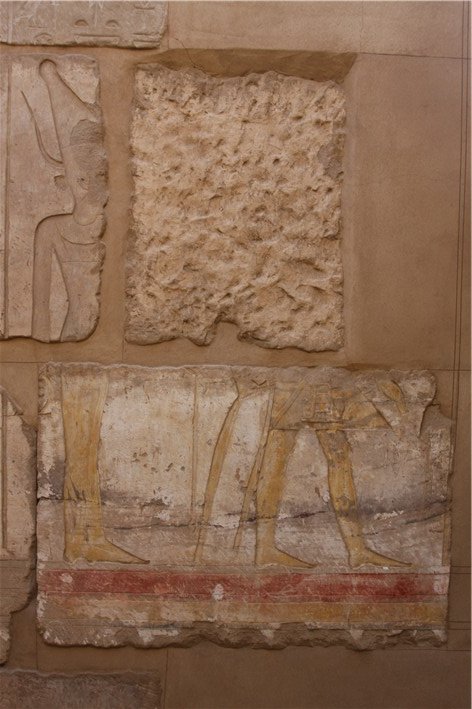
| The jambs of doorway D to F show on both sides figures of Senenmut (see
below) as they are known from the temple of
Hatshepsut at Deir el-Bahari.
|
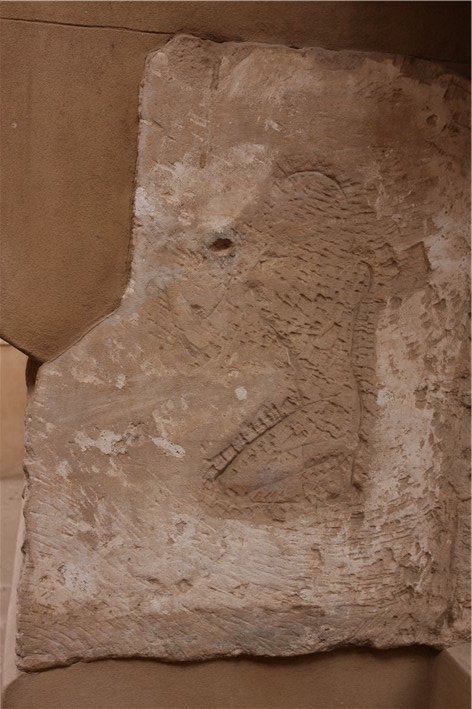
|
A scene on the rear wall of the northern room (B) which was dedicated to Amun-Ra
shows Thutmosis III. who is embraced by Amun-Ra. |
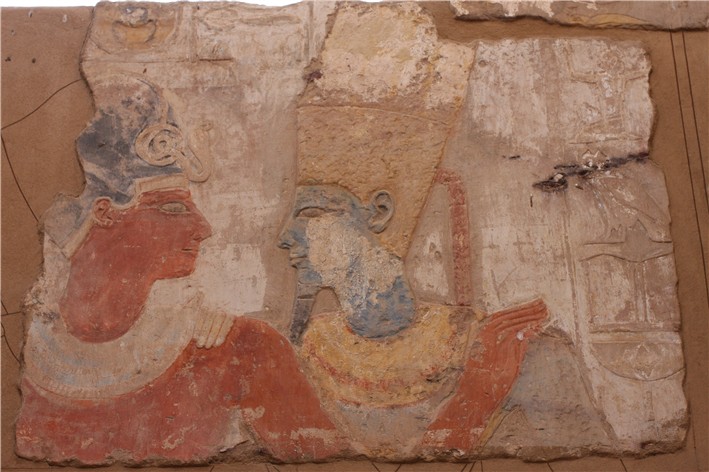
|
